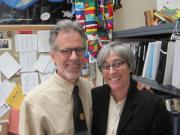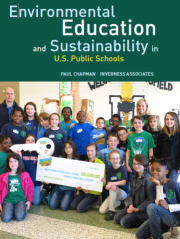California Environmental Literacy Blueprint Released
 This past year I was glad to serve on Superintendent of Public Instruction Tom Torlakson’s Environmental Literacy Task Force, and I was delighted the new California Blueprint for Environmental Literacy was released to the public on September 15, 2015 by Superintendent of Public Instruction Tom Torlakson.
This past year I was glad to serve on Superintendent of Public Instruction Tom Torlakson’s Environmental Literacy Task Force, and I was delighted the new California Blueprint for Environmental Literacy was released to the public on September 15, 2015 by Superintendent of Public Instruction Tom Torlakson.
The plan presents a vision for how all 6 million students in California can become environmental stewards and help address the significant environmental challenges we face. California is our nation’s largest and most diverse state, with a legacy of pioneering work in the field of environmental education and green and sustainable schools. I am proud of the new Blueprint for Environmental Literacy, and I hope it informs not only our work in the state, but across the nation.
The Blueprint is the latest in a series of milestone accomplishments for California in the field of environmental education and green, sustainable schools. In 2002 we were one of the first states to shape an environmental education plan, called “Education and the Environment: Strategic Initiatives for Enhancing Education in California,” and it quickly led to the passage of landmark legislation (AB 1548 and AB 1721) that mandated the creation of the California Education and the Environment Initiative (EEI) Curriculum, a K-12, 85 unit program that was approved in 2010 by the California State Board of Education for use throughout the state. Governor Arnold Governor Schwarzenegger signed the California Children’s Outdoor Bill of Rights in 2007 signaling the vital importance for students to spend time in nature. In 2011 I was a member of the Schools of the Future Task Force and wrote the recommendation that the Superintendent create an Environmental Literacy Plan. That same year the California Department of Education launched Green Ribbon Schools program, and I have been glad to serve on the committee that selects our exemplary private school nominee annually. The creation in 2014 of the Environmental Literacy Task Force has filled me with hope that our state’s leadership in this vital area will be fully realized.
The Task Force itself worked throughout 2014 to craft the plan. The 47 members included K-12 classroom teachers; school and district administrators; informal science educators; science, environmental, and outdoor educators; higher education faculty; and educational leaders from government agencies and nonprofits. Facilitated by the Glen Price Group, the process was led and supported by the staff of the California Department of Education. Importantly, the work of the Task Force was generously funded by the Pisces Foundation; the S.D. Bechtel, Jr. Foundation; Ten Strands; and The Californians Dedicated to Education Foundation.
California’s Blueprint for Environmental Literacy benefitted from and built upon the national effort to create plans in all fifty states. The No Child Left Inside (NCLI) legislation that was introduced in 2007 required that states have plans in order to be considered for funding. Beginning in 2008, the North American Association for Environmental Education announced that ELPs should include a five part framework: content standards, high school graduation requirements, teacher professional development, state education agency EL measurement of environmental literacy, and state education agency funding and implementation. The Blueprint addresses each of these components, but breaks new ground, especially in seeing the importance of integrating environmental education into existing initiatives like Common Core State Standards and the Next Generation Science Standards, and in incorporating a focus on underserved communities.
The California Blueprint begins by sketching a vision for environmental literacy. “Through abroad curriculum that includes expertly delivered classroom and out-of-classroom education by formal and informal educators,” we wrote, “students in California will become environmentally literate and able to address current environmental challenges and prevent new ones.” We also created our definition of environmental literacy, after reviewing plans from across the country.
“An environmentally literate person has the capacity to act individually and with others to support ecologically sound, economically prosperous, and equitable communities for present and future generations,” we noted. “Through lived experiences and education programs that include classroom-based lessons, experiential education, and outdoor learning, students will become environmentally literate, developing the knowledge, skills, and understanding of environmental principles to analyze environmental issues and make informed decisions.”
At a high level we defined six Guiding Principles for our continued work:
1. Equity of Access. We must achieve environmental literacy for all California students, not just a few.
2. Sustainability and Scalability of Systems. We must identify and commit to securing dedicated and sustained funding sources for environmental literacy and work within the current context of California’s education transformation to harness momentum and create long-term impact.
3. Collaborative Solutions. Collaboration among the many stakeholders and community partners involved in environmental literacy is critical to implementing the recommendations contained in this document.
4. Commitment to Quality. Students must have access to high-quality learning experiences and materials inside and outside of the classroom that cultivate environmental literacy. Formal and informal educators must have access to high quality professional learning opportunities.
5. Cultural Relevance and Competence. The success of environmental literacy efforts in California will hinge upon culturally competent educators utilizing educational resources and approaches that are responsive to the culture and experiences of the state’s diverse students and families.
6. Variety of Learning Experiences. Students can best develop environmental literacy through a combination of learning experiences in and out of the classroom, including outdoor and informal education, experiences in green school buildings and grounds, in students’ local parks, and in residential outdoor science programs.
The Blueprint identifies six strategies to achieve our vision of environmental literacy, each accompanied by detailed objectives to ensure implementation:
1: Integrate Environmental Literacy Efforts Into Existing and Future Education Initiatives
2: Strengthen Partnership and Collaboration Among Key Stakeholders
3: Mobilize the Public and Leverage the State Superintendent of Public Instruction’s Influence 1. Mobilize Public Will and Create Awareness of Strategies for Advancing Environmental Literacy
4: Implement Changes to Relevant State Law and Polic
5: Ensure Implementation through Capacity Building and Continuous Improvement
6. Develop a Sustainable Funding Strategy
I am grateful for the opportunity to have participated in the creation of California’s Blueprint for Environmental Literacy, and I am hopeful the plan will help us to make major improvements in environmental education and school sustainability. Our students deserve nothing less.
The full text of the Blueprint is available on the Inverness Associates website, invernessassociates.org.






